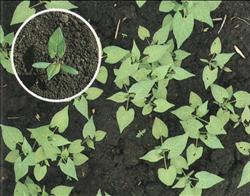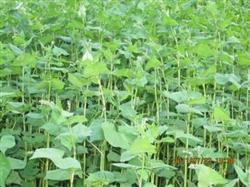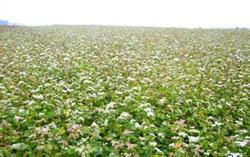Buckwheat needs less fertilizer, but fertilizer is expensive.

Buckwheat has short growth period, rapid growth, slender stem and underdeveloped root system, so it is a kind of crop that needs less fertilizer. Generally speaking, for every 100 kg buckwheat grain produced, about 3.3 kg of nitrogen, 1.5 kg of phosphorus and 4.3 kg of potassium need to be absorbed from the soil. The specific amount of fertilizer application will vary with soil texture, cultivation conditions, climate characteristics, harvest time and productivity. However, for dry and barren land and alpine mountain areas, the application of fertilizer is the basis of high yield. Buckwheat fertilization should be based on the principles of "giving priority to base fertilizer, planting fertilizer as auxiliary, topdressing fertilizer as supplement", "organic fertilizer as main, inorganic fertilizer as auxiliary" and "cooperation of nitrogen and phosphorus". Skillful application of base fertilizer: base fertilizer is the basic fertilizer, also known as base fertilizer, which is applied to the deep layer of soil before buckwheat sowing. Generally, 2000-3000 kg of fully mature farm manure is applied per mu. The base fertilizer can be evenly applied to the topsoil before the last ploughing and preparation. Skillful application of base fertilizer can not only fertilize the soil, mature the soil layer, create high-yield conditions, but also effectively promote the growth and development of roots and improve the absorption function of roots. At the same time, it can make use of the characteristics of "whole fertilizer" and "steady strength" of organic fertilizer to realize balanced fertilizer supply during the growth period and ensure steady growth. Skillfully applying topdressing: topdressing is a rapid fertilization measure taken to make up for the deficiency of base fertilizer and seed fertilizer in the process of buckwheat growth and development. The absorption and accumulation of nutrient elements are different in different growth stages. after bud development, a large number of elements are needed, but at this time, the supply capacity of soil nutrients is very low, so skillfully applying topdressing to supplement a certain amount of nutrient elements in time, it plays an important role in promoting the growth of buckwheat stems and leaves, the differentiation and development of flower buds and the formation of seeds. "promote bud fertilizer" generally look at the seedling topdressing urea 3-6 kg per mu. Note: do not use those that are growing vigorously. The flowering period is the period when buckwheat needs the most nutrients. For those with general growth, we should pay attention to the timely supply of urea and other available nitrogen fertilizer, so as to improve the healthy flower rate and seed setting rate. "Flower-promoting fertilizer" generally sees that seedlings can apply 3-6 kg of urea per mu. It is best to choose cloudy days or sooner or later to apply fertilizer. In addition, for those who lack fertility or show de-fertilization in the middle and later stages, foliar spraying fertilizer can be applied 1-2 times. Generally, 50 kg of 0.2% potassium dihydrogen phosphate solution can be sprayed evenly all over the stems and leaves per mu.
- Prev

Key points of cultivation techniques of buckwheat
Buckwheat is a good crop for filling leisure and disaster relief because of its short growth period, strong adaptability, moderate yield and high value of nutrition and health care. There is a habit of growing buckwheat all over our county. In order to achieve a stable yield and bumper harvest of buckwheat after the disaster, we must grasp the following key technical links: 1. Select improved varieties. It is appropriate to choose a growth period of 70 Mel for 80 days, with stress resistance.
- Next

Cultivation techniques for stable and High yield of Buckwheat
Mustard belongs to seed plant phylum, angiosperm class, dicotyledonous plant Polygonaceae. The variety has high nutritional value, cool, anti-inflammatory, help digestion, anti-aging and other health functions, with an average yield of about 100 kg per mu. Increase buckwheat per unit yield, increase total yield, to promote catering industry, processing industry, medicine and health care industry development.
Related
- The first cup of black tea in spring, the flavor and history of tea gardens in Kenya, Africa
- The computer can not only choose potatoes, but also grow tea rice. AI will grow winter oolong tea champion.
- It is not only the inflated tea bitten by insects, but also engraved with the four seasons tea in Beipu.
- The Oriental Beauty Tea Festival in Zhuxian County takes the stage at the weekend to experience the plus-size feast of oil tea.
- & quot; Oriental Beauty Tea & Exploration of Emei in Hsinchu, the hometown of quot;
- The new variety of strawberry "Tainong 1" dessert is the first choice with mellow aroma. Crimson gorgeous
- History of Tea in Taiwan: from Wild Inner Mountain to Export Tea Garden
- Two types of Taiwan Oriental Beauty Black Tea won the British three-Star Award for Childhood Tea Xiang Zhang Jiaqi changed from pilot to champion tea maker.
- Banana species and varieties: the planting history of Taiwan Xianren banana and dwarf banana is long, is banana disease resistant?
- Coffee planting Technology: Qianjie Coffee from Seedling to harvesting

